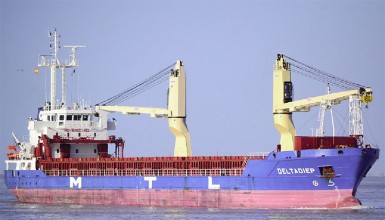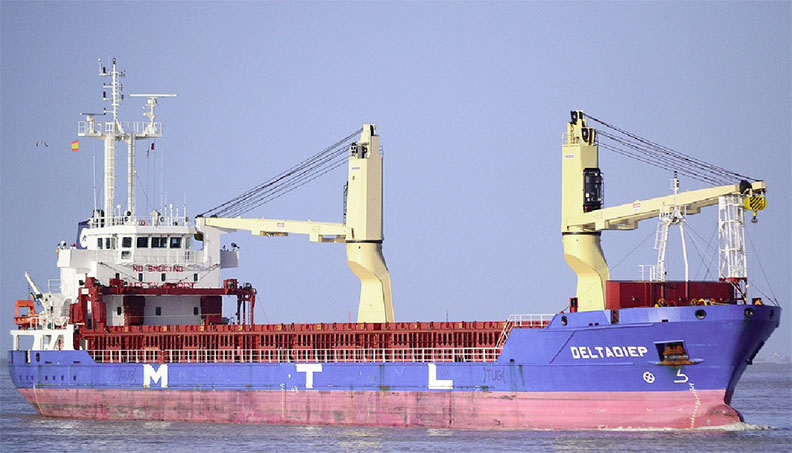The Guyana Revenue Authority (GRA) yesterday disclosed that it allowed the MV Deltadiep, which had been busted with some 192 kgs of cocaine, to leave Guyana after the payment of a $12 million fine, but AFC leader Khemraj Ramjattan says the amount is too meagre and will not act as a deterrent to drug traffickers.
The GRA disclosed the amount of the fine after days of efforts by Stabroek News and calls from political opposition members for the figure to be made public.
The 11-man crew left aboard the cargo vessel, without a single person being charged two Saturdays ago, after local authorities had 192.4 kilogrammes of cocaine in a container on board on January 6.
The GRA, which originally gave the value of the cocaine as $800 million, said the actual value was $2.1 billion.
 In a statement announcing the fine yesterday, the GRA said that the sum was reached following one week of negotiations with local law firm Cameron & Shepherd, which represented the owners and insurers of the vessel. It also noted that the figure was based on the precedent of the MV CFS Palamedes, which was discovered with 300 kilogrammes of cocaine in 2007. It was fined $15 million.
In a statement announcing the fine yesterday, the GRA said that the sum was reached following one week of negotiations with local law firm Cameron & Shepherd, which represented the owners and insurers of the vessel. It also noted that the figure was based on the precedent of the MV CFS Palamedes, which was discovered with 300 kilogrammes of cocaine in 2007. It was fined $15 million.
Ramjattan described the fine as “nothing,” when he was contacted yesterday for a reaction. He was among the persons calling for the figure to be made public. He called it a “government sham,” while contending that the big name drug traffickers are known but the trade is being ignored. “They just allow them to pay and go away,” he said. “This is why we are saying that it is a narco-state… the government and institutions which fall under it, like the GRA, are allowing it to happen,” he said.
Ramjattan questioned what would have been the fine if the drugs had successfully left Guyana and managed to make it all the way to Belgium or some other part of Europe. While emphasising that the fine was insignificant, he said in order for Guyana to send a strong message to drug traffickers who use the country as a transshipment point, ship owners ought to be made to pay huge fines.
He pointed out that when airlines are held in the United States of America with drugs on board, the owners are fined US$250,000, equivalent to $50 million. He questioned why Guyana extracted such a meagre sum out of a ship that is worth approximately US$2 million.
Ramjattan also said shippers know the difficulties Guyana faces when it comes to drug trafficking very well. “If we want to stop that we have got to up the ante,” he added. “We have to send a strong message otherwise we are going to keep encouraging them.”
In its statement, the GRA said the fine was levied by GRA Commis-sioner-General Khurshid Sattaur pursuant to the provisions made under Section 224 to 226 of the Customs Act, in lieu of the forfeiture which took effect on January 9, by way of a Notice of Seizure on account of the narcotics found on board the vessel.
Sattaur had previously told this newspaper that the GRA was exploring the payment of a fine as it was felt that this was the best option. He said that there was a number of factors that the GRA had to take into consideration, including the fact that the detention of the ship could have led action by international lawyers, a situation that the GRA was not in a position to deal with.
According to the GRA statement, intercepted packages found in a 40ft flat rack container on board the ship bore identification marks, such as the “Rolls Royce,” “JR,” “Super-man,” “XX,” “Playboy,” “Dolphin” and “Scissors” logos. Following the findings, eleven other flat rack containers were examined but no narcotic drugs were discovered in those containers, it said.
It also stated that following the discovery of the cocaine, the captain and crew, comprising two Polish nationals and nine Filipinos, were detained and escorted to CANU, while the container was transported to the GRA Warehouse Facility at Eccles for security purposes. However, it was noted that the Director of Public Prosecutions (DPP) recommended no prosecutions.
The ship had arrived in Guyana to load bauxite at Linden and was scheduled to travel to Belgium. The ship was also scheduled to make stops in Spain and Holland before reaching its final destination.
The drugs were un-earthed after GRA officials acted on a tip provided by the United Nations Office on Drug and Crime, which indicated that one of the containers onboard the vessel had cocaine. CANU was called in and together with officers of Guyana Revenue Authority’s Law Enforcement and Inves-tigation Division (LEID) and Drug Examination Unit (DEU) conducted an examination of the container. The investigation by CANU is ongoing.





